MITSUBISHI LANCER 2005 Workshop Manual
Manufacturer: MITSUBISHI, Model Year: 2005, Model line: LANCER, Model: MITSUBISHI LANCER 2005Pages: 788, PDF Size: 45.98 MB
Page 391 of 788
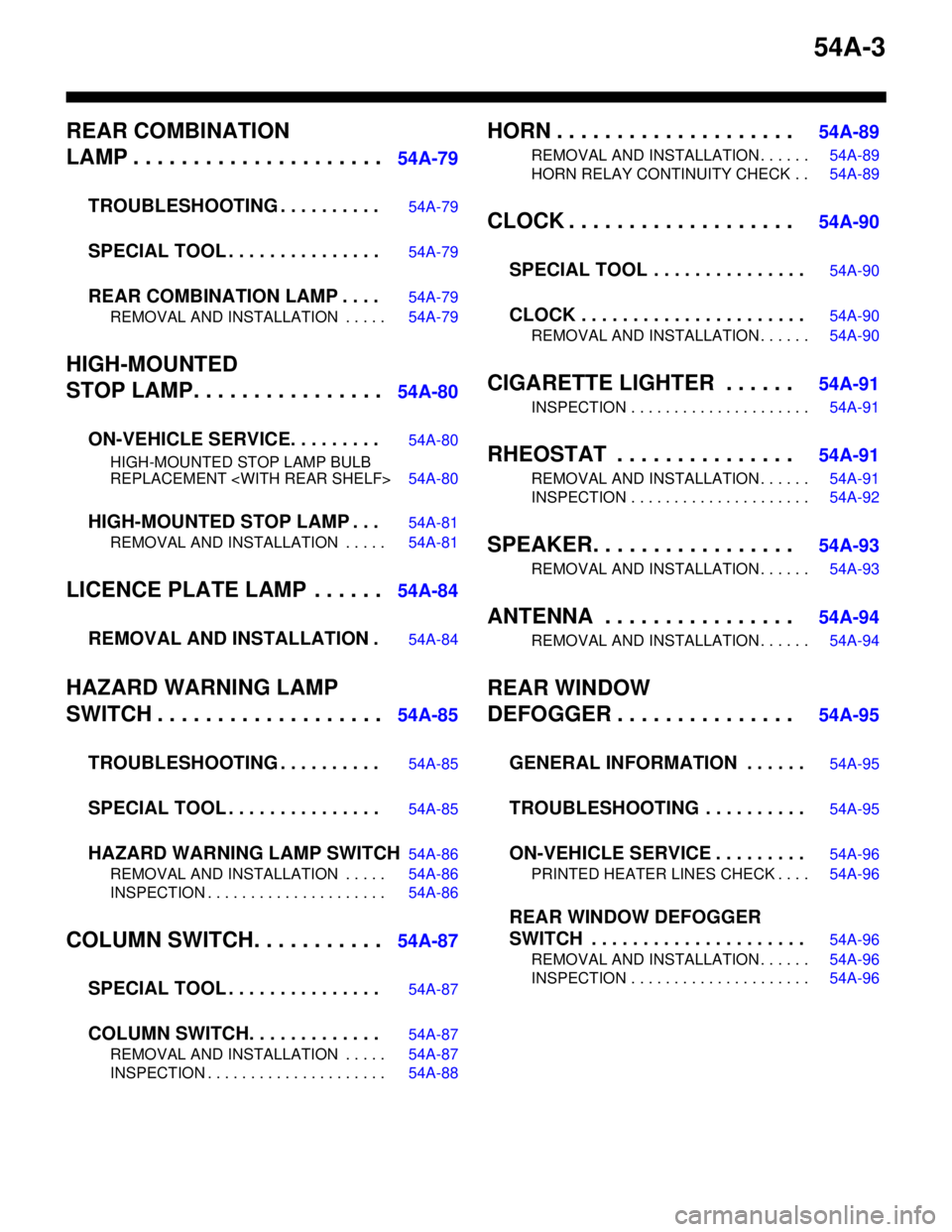
54A-3
REAR COMBINATION
LAMP . . . . . . . . . . . . . . . . . . . . .
54A-79
TROUBLESHOOTING . . . . . . . . . .
54A-79
SPECIAL TOOL . . . . . . . . . . . . . . .54A-79
REAR COMBINATION LAMP . . . .54A-79
REMOVAL AND INSTALLATION . . . . . 54A-79
HIGH-MOUNTED
STOP LAMP. . . . . . . . . . . . . . . .
54A-80
ON-VEHICLE SERVICE. . . . . . . . .
54A-80
HIGH-MOUNTED STOP LAMP BULB
REPLACEMENT
HIGH-MOUNTED STOP LAMP . . .54A-81
REMOVAL AND INSTALLATION . . . . . 54A-81
LICENCE PLATE LAMP . . . . . .54A-84
REMOVAL AND INSTALLATION .
54A-84
HAZARD WARNING LAMP
SWITCH . . . . . . . . . . . . . . . . . . .
54A-85
TROUBLESHOOTING . . . . . . . . . .
54A-85
SPECIAL TOOL . . . . . . . . . . . . . . .54A-85
HAZARD WARNING LAMP SWITCH54A-86
REMOVAL AND INSTALLATION . . . . . 54A-86
INSPECTION . . . . . . . . . . . . . . . . . . . . . 54A-86
COLUMN SWITCH. . . . . . . . . . .54A-87
SPECIAL TOOL . . . . . . . . . . . . . . .
54A-87
COLUMN SWITCH. . . . . . . . . . . . .54A-87
REMOVAL AND INSTALLATION . . . . . 54A-87
INSPECTION . . . . . . . . . . . . . . . . . . . . . 54A-88
HORN . . . . . . . . . . . . . . . . . . . . 54A-89
REMOVAL AND INSTALLATION . . . . . . 54A-89
HORN RELAY CONTINUITY CHECK . . 54A-89
CLOCK . . . . . . . . . . . . . . . . . . . 54A-90
SPECIAL TOOL . . . . . . . . . . . . . . .
54A-90
CLOCK . . . . . . . . . . . . . . . . . . . . . .54A-90
REMOVAL AND INSTALLATION . . . . . . 54A-90
CIGARETTE LIGHTER . . . . . . 54A-91
INSPECTION . . . . . . . . . . . . . . . . . . . . . 54A-91
RHEOSTAT . . . . . . . . . . . . . . . 54A-91
REMOVAL AND INSTALLATION . . . . . . 54A-91
INSPECTION . . . . . . . . . . . . . . . . . . . . . 54A-92
SPEAKER. . . . . . . . . . . . . . . . . 54A-93
REMOVAL AND INSTALLATION . . . . . . 54A-93
ANTENNA . . . . . . . . . . . . . . . . 54A-94
REMOVAL AND INSTALLATION . . . . . . 54A-94
REAR WINDOW
DEFOGGER . . . . . . . . . . . . . . .
54A-95
GENERAL INFORMATION . . . . . .
54A-95
TROUBLESHOOTING . . . . . . . . . .54A-95
ON-VEHICLE SERVICE . . . . . . . . .54A-96
PRINTED HEATER LINES CHECK . . . . 54A-96
REAR WINDOW DEFOGGER
SWITCH . . . . . . . . . . . . . . . . . . . . .
54A-96
REMOVAL AND INSTALLATION . . . . . . 54A-96
INSPECTION . . . . . . . . . . . . . . . . . . . . . 54A-96
Page 392 of 788
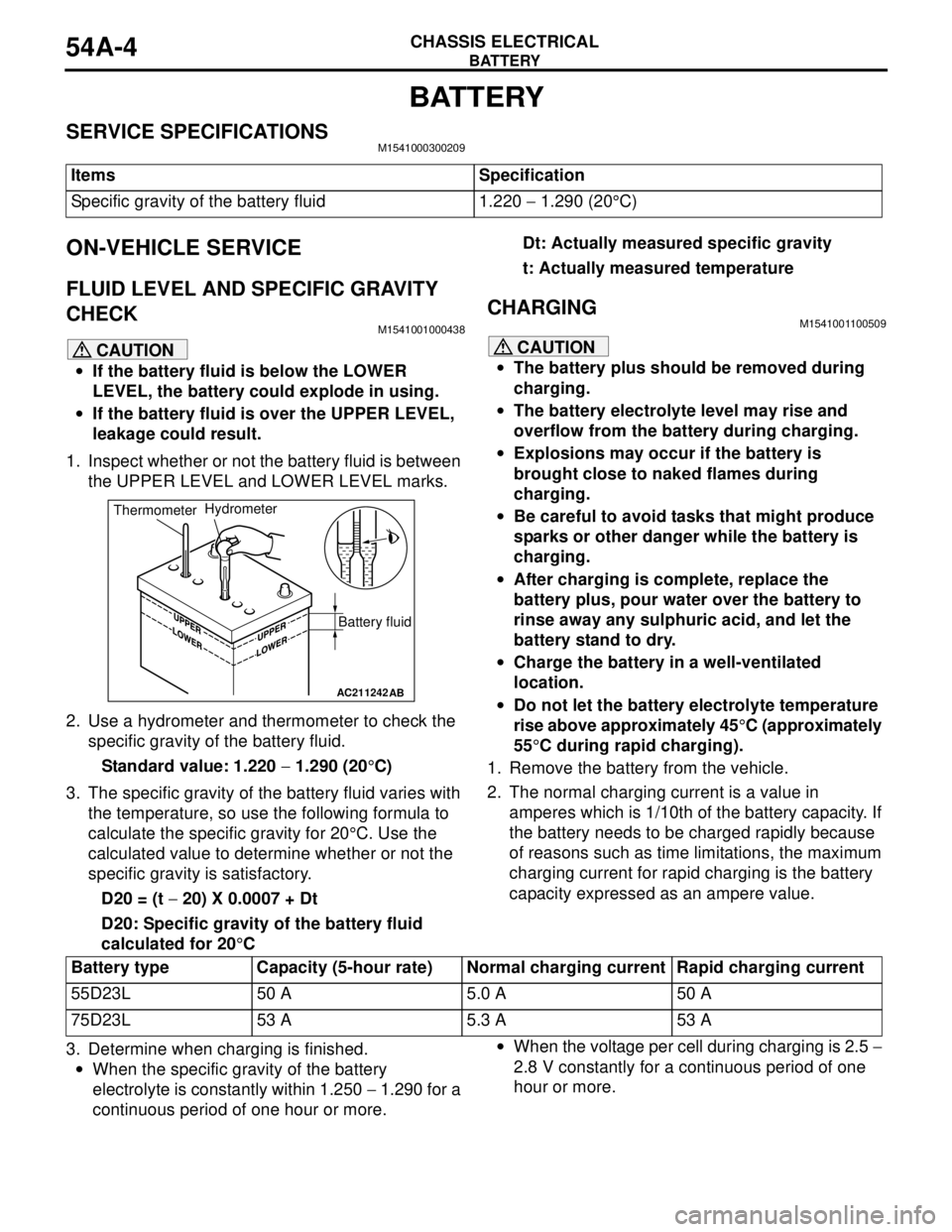
BATTERY
CHASSIS ELECTRICAL54A-4
BATTERY
SERVICE SPECIFICATIONSM1541000300209
ON-VEHICLE SERVICE
FLUID LEVEL AND SPECIFIC GRAVITY
CHECK
M1541001000438
CAUTION
•If the battery fluid is below the LOWER
LEVEL, the battery could explode in using.
•If the battery fluid is over the UPPER LEVEL,
leakage could result.
1. Inspect whether or not the battery fluid is between
the UPPER LEVEL and LOWER LEVEL marks.
2. Use a hydrometer and thermometer to check the
specific gravity of the battery fluid.
Standard value: 1.220 − 1.290 (20°C)
3. The specific gravity of the battery fluid varies with
the temperature, so use the following formula to
calculate the specific gravity for 20°C. Use the
calculated value to determine whether or not the
specific gravity is satisfactory.
D20 = (t − 20) X 0.0007 + Dt
D20: Specific gravity of the battery fluid
calculated for 20°CDt: Actually measured specific gravity
t: Actually measured temperature
CHARGINGM1541001100509
CAUTION
•The battery plus should be removed during
charging.
•The battery electrolyte level may rise and
overflow from the battery during charging.
•Explosions may occur if the battery is
brought close to naked flames during
charging.
•Be careful to avoid tasks that might produce
sparks or other danger while the battery is
charging.
•After charging is complete, replace the
battery plus, pour water over the battery to
rinse away any sulphuric acid, and let the
battery stand to dry.
•Charge the battery in a well-ventilated
location.
•Do not let the battery electrolyte temperature
rise above approximately 45°C (approximately
55°C during rapid charging).
1. Remove the battery from the vehicle.
2. The normal charging current is a value in
amperes which is 1/10th of the battery capacity. If
the battery needs to be charged rapidly because
of reasons such as time limitations, the maximum
charging current for rapid charging is the battery
capacity expressed as an ampere value.
3. Determine when charging is finished.
•When the specific gravity of the battery
electrolyte is constantly within 1.250 − 1.290 for a
continuous period of one hour or more.•When the voltage per cell during charging is 2.5 −
2.8 V constantly for a continuous period of one
hour or more. Items Specification
Specific gravity of the battery fluid 1.220 − 1.290 (20°C)
AC211242AB
Battery fluid ThermometerHydrometer
Battery type Capacity (5-hour rate) Normal charging current Rapid charging current
55D23L 50 A 5.0 A 50 A
75D23L 53 A 5.3 A 53 A
Page 393 of 788
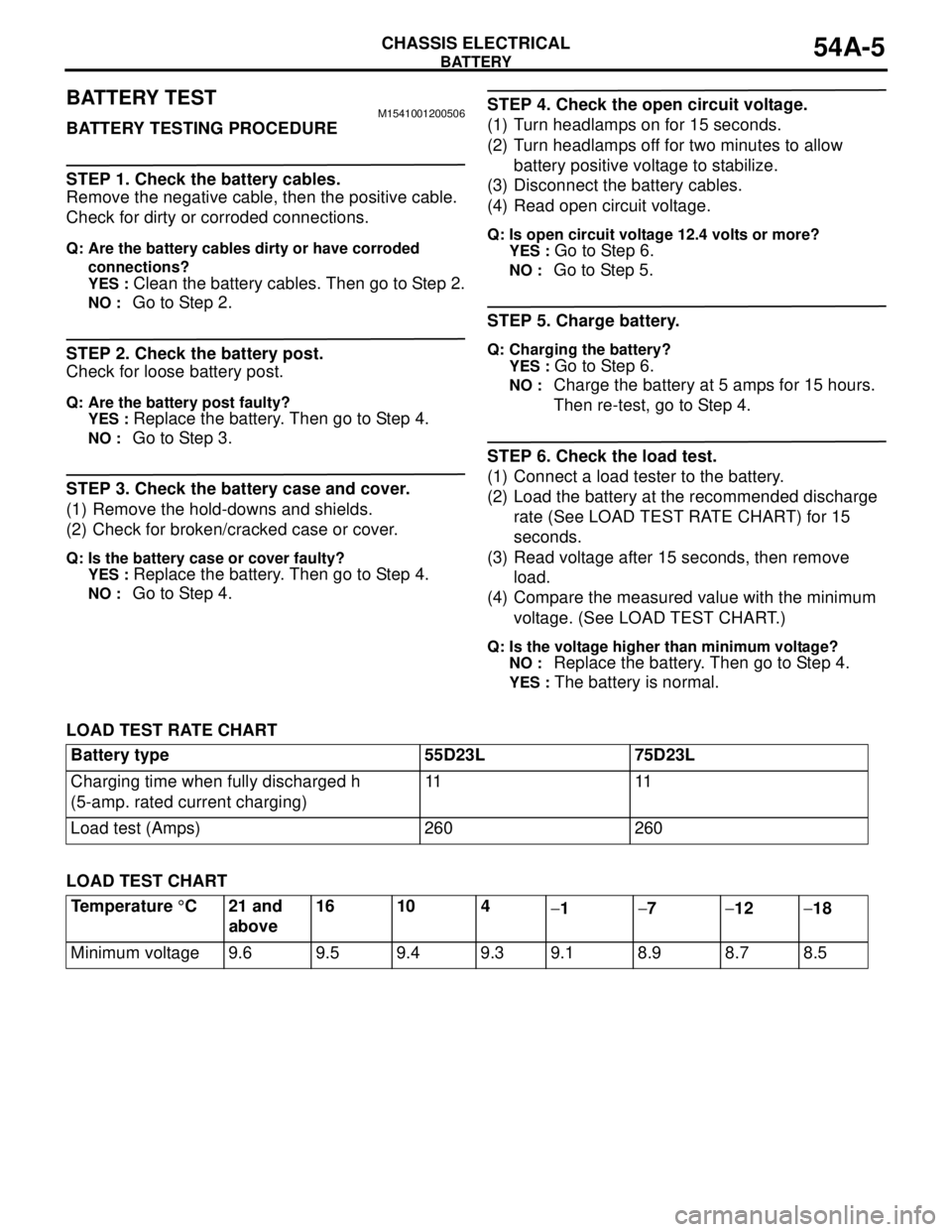
BATTERY
CHASSIS ELECTRICAL54A-5
BATTERY TESTM1541001200506
BATTERY TESTING PROCEDURE
STEP 1. Check the battery cables.
Remove the negative cable, then the positive cable.
Check for dirty or corroded connections.
Q: Are the battery cables dirty or have corroded
connections?
YES :
Clean the battery cables. Then go to Step 2.
NO : Go to Step 2.
STEP 2. Check the battery post.
Check for loose battery post.
Q: Are the battery post faulty?
YES :
Replace the battery. Then go to Step 4.
NO : Go to Step 3.
STEP 3. Check the battery case and cover.
(1) Remove the hold-downs and shields.
(2) Check for broken/cracked case or cover.
Q: Is the battery case or cover faulty?
YES :
Replace the battery. Then go to Step 4.
NO : Go to Step 4.
STEP 4. Check the open circuit voltage.
(1) Turn headlamps on for 15 seconds.
(2) Turn headlamps off for two minutes to allow
battery positive voltage to stabilize.
(3) Disconnect the battery cables.
(4) Read open circuit voltage.
Q: Is open circuit voltage 12.4 volts or more?
YES :
Go to Step 6.
NO : Go to Step 5.
STEP 5. Charge battery.
Q: Charging the battery?
YES :
Go to Step 6.
NO : Charge the battery at 5 amps for 15 hours.
Then re-test, go to Step 4.
STEP 6. Check the load test.
(1) Connect a load tester to the battery.
(2) Load the battery at the recommended discharge
rate (See LOAD TEST RATE CHART) for 15
seconds.
(3) Read voltage after 15 seconds, then remove
load.
(4) Compare the measured value with the minimum
voltage. (See LOAD TEST CHART.)
Q: Is the voltage higher than minimum voltage?
NO :
Replace the battery. Then go to Step 4.
YES : The battery is normal.
LOAD TEST RATE CHART
LOAD TEST CHARTBattery type 55D23L 75D23L
Charging time when fully discharged h
(5-amp. rated current charging)11 11
Load test (Amps) 260 260
Temperature °C 21 and
above16 10 4
−1−7−12−18
Minimum voltage 9.6 9.5 9.4 9.3 9.1 8.9 8.7 8.5
Page 394 of 788
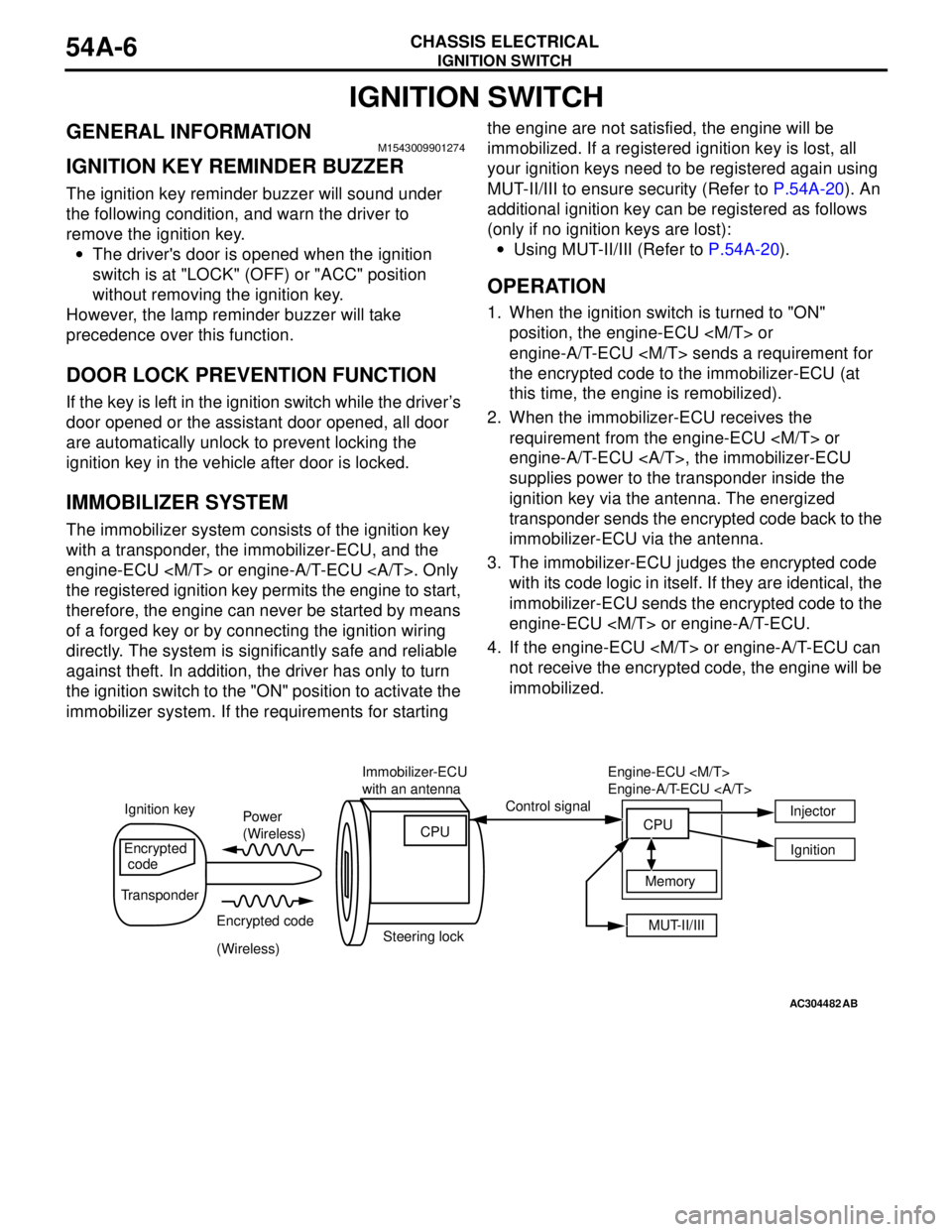
IGNITION SWITCH
CHASSIS ELECTRICAL54A-6
IGNITION SWITCH
GENERAL INFORMATIONM1543009901274
IGNITION KEY REMINDER BUZZER
The ignition key reminder buzzer will sound under
the following condition, and warn the driver to
remove the ignition key.
•The driver's door is opened when the ignition
switch is at "LOCK" (OFF) or "ACC" position
without removing the ignition key.
However, the lamp reminder buzzer will take
precedence over this function.
DOOR LOCK PREVENTION FUNCTION
If the key is left in the ignition switch while the driver’s
door opened or the assistant door opened, all door
are automatically unlock to prevent locking the
ignition key in the vehicle after door is locked.
IMMOBILIZER SYSTEM
The immobilizer system consists of the ignition key
with a transponder, the immobilizer-ECU, and the
engine-ECU
the registered ignition key permits the engine to start,
therefore, the engine can never be started by means
of a forged key or by connecting the ignition wiring
directly. The system is significantly safe and reliable
against theft. In addition, the driver has only to turn
the ignition switch to the "ON" position to activate the
immobilizer system. If the requirements for starting the engine are not satisfied, the engine will be
immobilized. If a registered ignition key is lost, all
your ignition keys need to be registered again using
MUT-II/III to ensure security (Refer to P.54A-20). An
additional ignition key can be registered as follows
(only if no ignition keys are lost):
•Using MUT-II/III (Refer to P.54A-20).
OPERATION
1. When the ignition switch is turned to "ON"
position, the engine-ECU
engine-A/T-ECU
the encrypted code to the immobilizer-ECU (at
this time, the engine is remobilized).
2. When the immobilizer-ECU receives the
requirement from the engine-ECU
engine-A/T-ECU , the immobilizer-ECU
supplies power to the transponder inside the
ignition key via the antenna. The energized
transponder sends the encrypted code back to the
immobilizer-ECU via the antenna.
3. The immobilizer-ECU judges the encrypted code
with its code logic in itself. If they are identical, the
immobilizer-ECU sends the encrypted code to the
engine-ECU
4. If the engine-ECU
not receive the encrypted code, the engine will be
immobilized.
AC304482AB
Power
(Wireless)
Encrypted code
(Wireless) Ignition keyControl signal
Encrypted
code
TransponderImmobilizer-ECU
with an antenna
Steering lockCPU
MUT-II/III Memory Engine-ECU
Engine-A/T-ECU
CPUInjector
Ignition
Page 395 of 788

IGNITION SWITCH
CHASSIS ELECTRICAL54A-7
Encrypted code registration criteria table
The ignition key contains a transponder (small
transmitter), which retains an unique encrypted code.
Under any of the conditions below, the encrypted
code should be registered in the immobilizer-ECU
again. The immobilizer-ECU can retain maximum
eight different encrypted codes. This means that
maximum eight ignition keys can be registered.
Component to be replaced Engine-A/T-ECU Immobilizer-ECU Ignition key
When engine-A/T-ECU is
replaced−Should not be
replacedShould not be replaced
Should be registered
again
When engine-A/T-ECU is
overwritten−Should not be
replacedShould not be replaced
Should be registered
again
When immobilizer-ECU is
replaceShould not be
replaced−Should not be replaced
All ignition keys should be
registered again
When ignition key is added Should not be
replacedShould not be
replaced•Additional ignition key
should be registered
•All ignition keys should
be registered again
When ignition key is lost Should not be
replacedShould not be
replacedAll the ignition keys other
than the lost one should
be registered again
Page 396 of 788
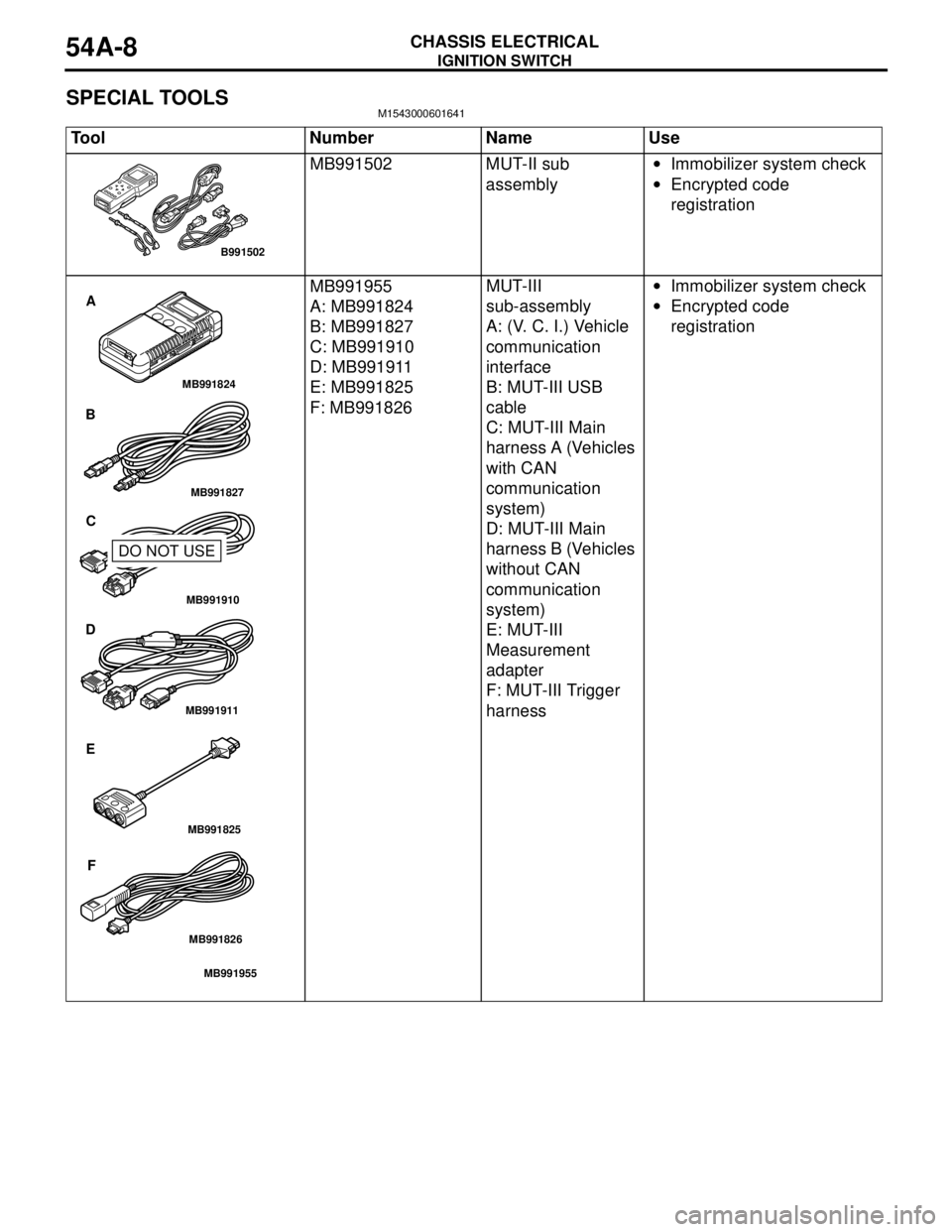
IGNITION SWITCH
CHASSIS ELECTRICAL54A-8
SPECIAL TOOLSM1543000601641
Tool Number Name Use
MB991502 MUT-II sub
assembly•Immobilizer system check
•Encrypted code
registration
MB991955
A: MB991824
B: MB991827
C: MB991910
D: MB991911
E: MB991825
F: MB991826MUT-III
sub-assembly
A: (V. C. I.) Vehicle
communication
interface
B: MUT-III USB
cable
C: MUT-III Main
harness A (Vehicles
with CAN
communication
system)
D: MUT-III Main
harness B (Vehicles
without CAN
communication
system)
E: MUT-III
Measurement
adapter
F: MUT-III Trigger
harness•Immobilizer system check
•Encrypted code
registration
B991502
MB991910
MB991826
MB991955
MB991911
MB991824
MB991827
MB991825
A
B
C
D
E
F
DO NOT USE
Page 397 of 788
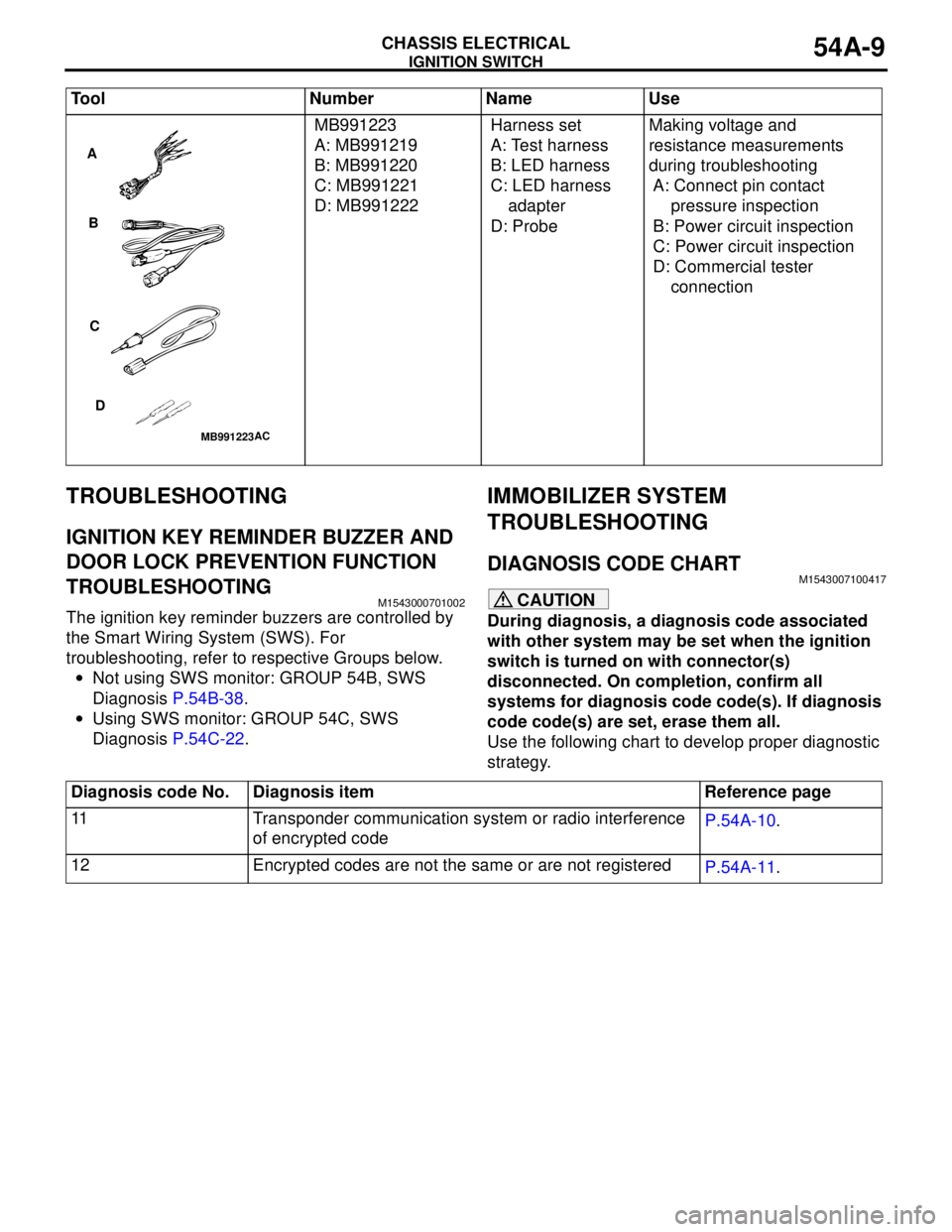
IGNITION SWITCH
CHASSIS ELECTRICAL54A-9
TROUBLESHOOTING
IGNITION KEY REMINDER BUZZER AND
DOOR LOCK PREVENTION FUNCTION
TROUBLESHOOTING
M1543000701002
The ignition key reminder buzzers are controlled by
the Smart Wiring System (SWS). For
troubleshooting, refer to respective Groups below.
•Not using SWS monitor: GROUP 54B, SWS
Diagnosis P.54B-38.
•Using SWS monitor: GROUP 54C, SWS
Diagnosis P.54C-22.
IMMOBILIZER SYSTEM
TROUBLESHOOTING
DIAGNOSIS CODE CHARTM1543007100417
CAUTION
During diagnosis, a diagnosis code associated
with other system may be set when the ignition
switch is turned on with connector(s)
disconnected. On completion, confirm all
systems for diagnosis code code(s). If diagnosis
code code(s) are set, erase them all.
Use the following chart to develop proper diagnostic
strategy. MB991223
A: MB991219
B: MB991220
C: MB991221
D: MB991222Harness set
A: Test harness
B: LED harness
C: LED harness
adapter
D: ProbeMaking voltage and
resistance measurements
during troubleshooting
A: Connect pin contact
pressure inspection
B: Power circuit inspection
C: Power circuit inspection
D: Commercial tester
connection Tool Number Name Use
MB991223
A
B
C
D
AC
Diagnosis code No. Diagnosis item Reference page
11 Transponder communication system or radio interference
of encrypted codeP.54A-10.
12 Encrypted codes are not the same or are not registered
P.54A-11.
Page 398 of 788
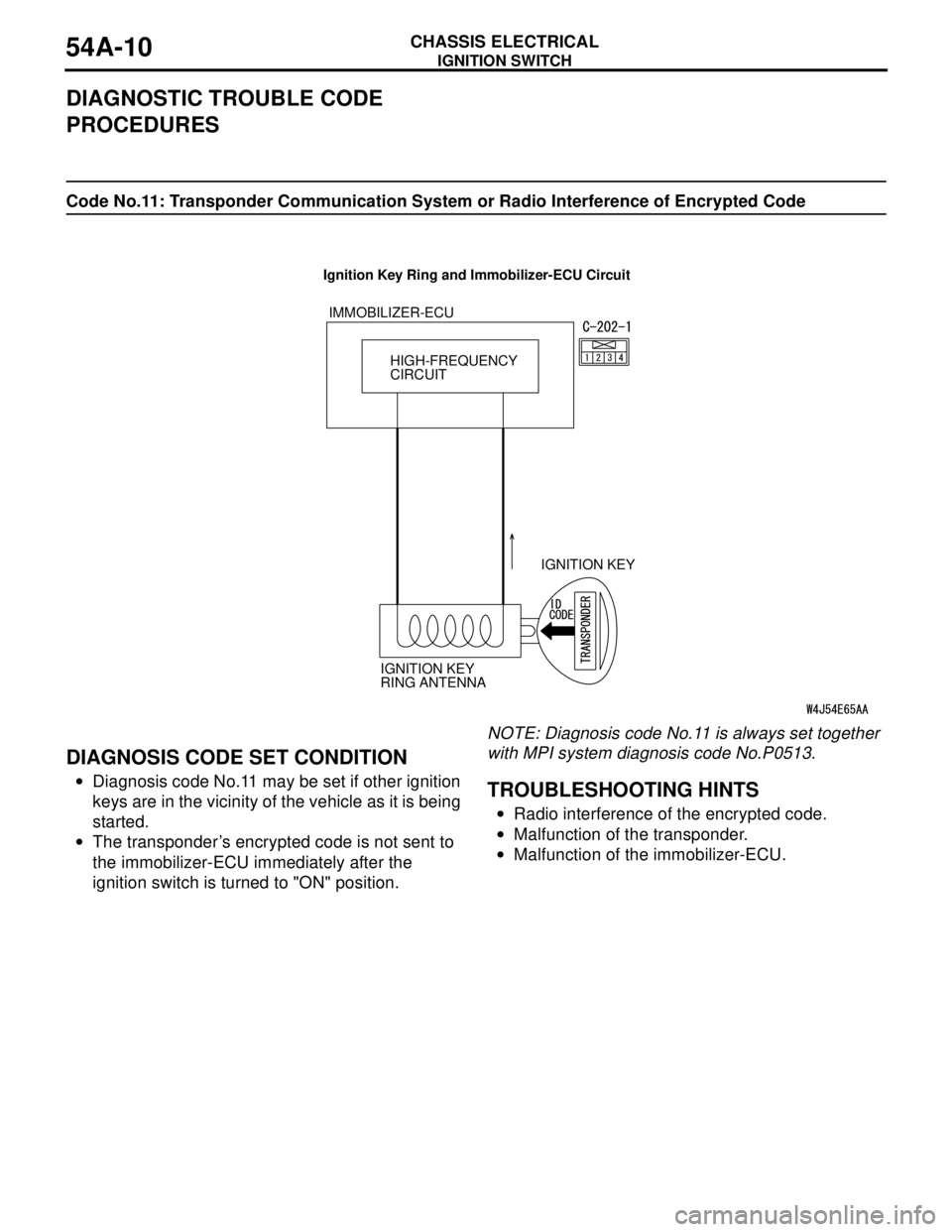
IGNITION SWITCH
CHASSIS ELECTRICAL54A-10
DIAGNOSTIC TROUBLE CODE
PROCEDURES
Code No.11: Transponder Communication System or Radio Interference of Encrypted Code
DIAGNOSIS CODE SET CONDITION
•Diagnosis code No.11 may be set if other ignition
keys are in the vicinity of the vehicle as it is being
started.
•The transponder’s encrypted code is not sent to
the immobilizer-ECU immediately after the
ignition switch is turned to "ON" position.NOTE: Diagnosis code No.11 is always set together
with MPI system diagnosis code No.P0513.TROUBLESHOOTING HINTS
•Radio interference of the encrypted code.
•Malfunction of the transponder.
•Malfunction of the immobilizer-ECU.
HIGH-FREQUENCY
CIRCUIT IMMOBILIZER-ECU
IGNITION KEY
IGNITION KEY
RING ANTENNA
Ignition Key Ring and Immobilizer-ECU Circuit
Page 399 of 788
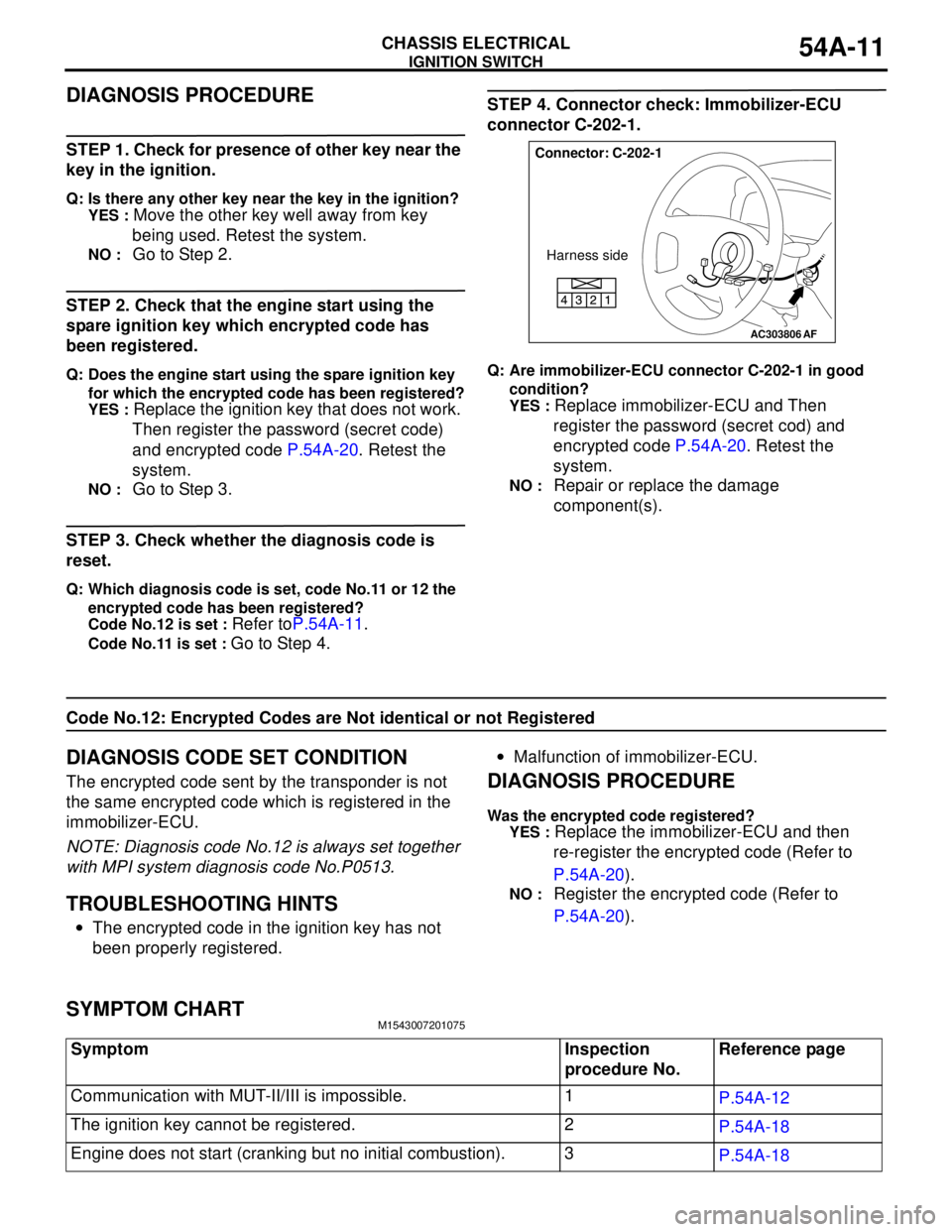
IGNITION SWITCH
CHASSIS ELECTRICAL54A-11
DIAGNOSIS PROCEDURE
STEP 1. Check for presence of other key near the
key in the ignition.
Q: Is there any other key near the key in the ignition?
YES :
Move the other key well away from key
being used. Retest the system.
NO : Go to Step 2.
STEP 2. Check that the engine start using the
spare ignition key which encrypted code has
been registered.
Q: Does the engine start using the spare ignition key
for which the encrypted code has been registered?
YES :
Replace the ignition key that does not work.
Then register the password (secret code)
and encrypted code P.54A-20. Retest the
system.
NO : Go to Step 3.
STEP 3. Check whether the diagnosis code is
reset.
Q: Which diagnosis code is set, code No.11 or 12 the
encrypted code has been registered?
Code No.12 is set :
Refer toP.54A-11.
Code No.11 is set : Go to Step 4.
STEP 4. Connector check: Immobilizer-ECU
connector C-202-1.
Q: Are immobilizer-ECU connector C-202-1 in good
condition?
YES :
Replace immobilizer-ECU and Then
register the password (secret cod) and
encrypted code P.54A-20. Retest the
system.
NO : Repair or replace the damage
component(s).
Code No.12: Encrypted Codes are Not identical or not Registered
DIAGNOSIS CODE SET CONDITION
The encrypted code sent by the transponder is not
the same encrypted code which is registered in the
immobilizer-ECU.
NOTE: Diagnosis code No.12 is always set together
with MPI system diagnosis code No.P0513.
TROUBLESHOOTING HINTS
•The encrypted code in the ignition key has not
been properly registered.•Malfunction of immobilizer-ECU.
DIAGNOSIS PROCEDURE
Was the encrypted code registered?
YES :
Replace the immobilizer-ECU and then
re-register the encrypted code (Refer to
P.54A-20).
NO : Register the encrypted code (Refer to
P.54A-20).
SYMPTOM CHARTM1543007201075
AC303806
Connector: C-202-1
Harness side
AF
Symptom Inspection
procedure No.Reference page
Communication with MUT-II/III is impossible. 1
P.54A-12
The ignition key cannot be registered. 2
P.54A-18
Engine does not start (cranking but no initial combustion). 3
P.54A-18
Page 400 of 788
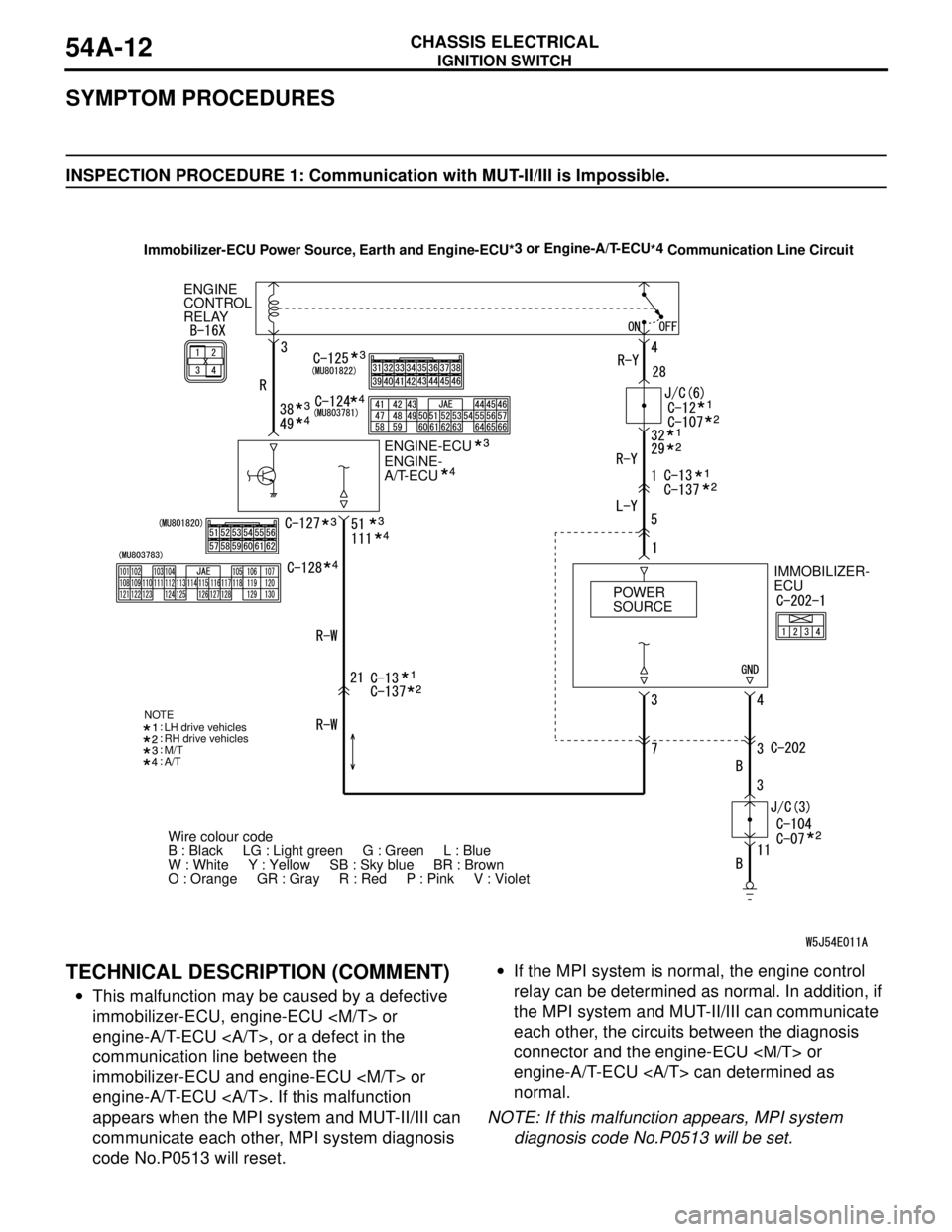
IGNITION SWITCH
CHASSIS ELECTRICAL54A-12
SYMPTOM PROCEDURES
INSPECTION PROCEDURE 1: Communication with MUT-II/III is Impossible.
TECHNICAL DESCRIPTION (COMMENT)
•This malfunction may be caused by a defective
immobilizer-ECU, engine-ECU
engine-A/T-ECU , or a defect in the
communication line between the
immobilizer-ECU and engine-ECU
engine-A/T-ECU . If this malfunction
appears when the MPI system and MUT-II/III can
communicate each other, MPI system diagnosis
code No.P0513 will reset.•If the MPI system is normal, the engine control
relay can be determined as normal. In addition, if
the MPI system and MUT-II/III can communicate
each other, the circuits between the diagnosis
connector and the engine-ECU
engine-A/T-ECU can determined as
normal.
NOTE: If this malfunction appears, MPI system
diagnosis code No.P0513 will be set.
ENGINE-ECU ENGINE
CONTROL
RELAY
ENGINE-
A/T-ECU
IMMOBILIZER-
ECU
Wire colour code
B : Black LG : Light green G : Green L : Blue
W : White Y : Yellow SB : Sky blue BR : Brown
O : Orange GR : Gray R : Red P : Pink V : Violet POWER
SOURCE
M/T
A/T NOTE
LH drive vehicles
RH drive vehicles
Immobilizer-ECU Power Source, Earth and Engine-ECU*3 or Engine-A/T-ECU
*4
Communication Line Circuit